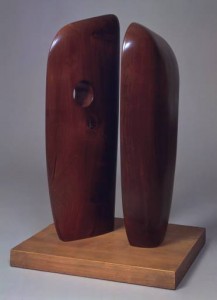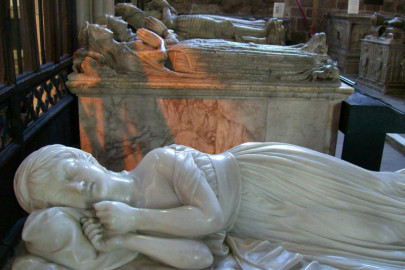Visiting Stonehenge this half-term? Here’s Alexandra Harris’ post on its influence on British culture, from Turner to Hepworth…
Stonehenge is a good example of how a particular landmark in the English countryside could inspire different kinds of appreciation. Its image was particularly potent because it signified strength and endurance while at the same time being vulnerable, and seeming to stand for a vulnerable England.
Like so many areas, Salisbury Plain faced the prospect of development. The stone circle itself was under government protection, but the area surrounding it was still in private hands by the late 1920s and liable to be built on at any moment. A Stonehenge Cafe had already sprung up to take advantage of the tourist trade (it is visible in photographs from 1927), and commentators anxiously surmised that other buildings would follow. A major appeal was launched, backed by both Stanley Baldwin and Ramsay McDonald, to buy the surrounding area and place it in the safe-keeping of the National Trust. The rhetoric of the appeal was stirring:
“The solitude of Stonehenge should be restored and precautions taken to ensure that our posterity will see it against the sky in the lonely majesty before which our ancestors have stood in awe throughout all our recorded history.”
Money came in fast; modernity in the form of cafes and carparks was (for the moment) fended off. But Stonehenge was nonetheless a modern icon. For centuries the ancient stones had been at the forefront of modern art. The structures and proportions favoured by the Neoliths had been borrowed by architects like John Wood in the eighteenth-century to give gravitas to his classical façades in Bath. The columns and pediments derived from Rome of course, but they derived from early England too. And then the stones became Romantic: for Turner they glistened like a golden city in shafts of sunlight; Constable saw them touched by a rainbow from a tumultuous sky, as if still making the covenant with the gods first established thousands of years before. Between the wars, Stonehenge continued its protean career.
Paul Nash found equivalents for the megaliths, replacing standing stones with geometric forms and thereby declaring that they could be read as abstract art. Measuring Salisbury Plain against a Miró painting, Piper suggested similar affinities. Advanced architectural thinkers admired the same formal properties in the stones that had appealed to the builders at Bath. Among the pictures of purist villas and abstract constructions in art journal Circle a series of Stonehenge photographs appeared. Two were by the German writer Carola Giedion-Welcker, a specialist on contemporary sculpture, and a third was by Walter Gropius, the leader of the Bauhaus. Both photographers went up close and stayed near to the ground, feeling the weight of the stones rising above them. Barbara Hepworth, designing the layout for Circle,placed these pictures after her own essay on sculpture which took the understanding of form and gravity to be the primary work of the sculptor. Neolithic man, it seemed, had been an unrivalled master of form, and his influence can be clearly felt in Hepworth’s work from this time. Though they were only a metre high, she saw her Two Forms in Echelon (1938) as monuments in the landscape: ‘the sculpture has an upward growth but the two monoliths make a closed composition,’ she said, which creates a space of ‘quietness’ out in the open.
Here were monoliths you could live with. Hepworth imagined the sculpture in a garden setting, domesticating the sarsens while preserving their power. Henry Moore, too, wanted the monoliths in his garden. When he bought an area of land large enough to position his sculptures out of doors he rejoiced that they looked ‘like a bit of Stonehenge’. He had first seen Stonehenge by night in 1921, in the days when you could wander alone through the stones and watch the moon. The experience stayed with him all his life (he recalled as an elderly man the ‘mysterious depths’ of those moonlit stones), and the magnetic equilibrium of his large sculptures in landscape were part of his life-long tribute to the ancient builders. Moore, Betjeman, Piper, Hepworth, Gropius: pre-history had an impressive list of modern advocates appropriating its monuments for their various visions of England.
Alexandra Harris is the author of Romantic Moderns – you can see her website here.













I drove past the new visitor centre the other day, an improvement on the previous building – but not by much…
The current exhibition in the visitor centre – on Stonehenge’s context in the landscape – is rather superb though. I quite like the new building, also – it will be interesting to see how it settles into the landscape. It’s no mean feat catering for a million visitors a year
Not sure about the Gropius connection although it would depend upon when he visited Stonehenge, Walter’s reason for getting up in the morning was his driving ambition…the marriage of art and the industrial process and the politics of fund-raising. His mantra, form following function, could hardly have had any connection with stone circles, even now their function is not absolutely clear, back in his day, pure guesswork.
Although, stand this on it’s end and remove the glass? Stand this on it’s end and it looks the same as it did lying down, demolished as soon as the Werkbund exhibition was finished, recent excavations for the new Rhein embankment wall at Deutz may have uncovered some of it’s remains. This Bauhaus inspired complex is undoubtedly more rectangular then circular although, like Stonehenge, it is a monument, to king coal.
I have a CD of Vaughan Williams Ninth Symphony; it has sat on a shelf for at least twenty years, neglected, ignored; bought, I now suspect, because it completed the full set of the great composer’s symphonies: written when he was 85; I mean, 85, come on! A doddery old bloke close to death; his best days long gone. Why don’t these ancients pack-up before they do lasting damage to their reputations? Last Friday I accepted an invitation from a daughter to an all-expenses-paid concert at the Bridgewater Hall in Manchester. What’s on? RVW’s Ninth! Is that okay? Of course! (Liar! Oh, why not the second, third, fourth, fifth………even the eighth). I vaguely remembered it was in some ways programmatic, inspired by Thomas Hardy’s Tess? What was it his wife Ursula had said about it? “Ralph started work on his ninth symphony when he was eighty four. He finished it in about a year. It had a sort of programme to do with Salisbury and Salisbury Plain where he had so often walked with friends; where he had done part of his military training, and of thoughts of Hardy’s Tess of the d’urbervilles who spent her last night of freedom at Stonehenge.” As I listened to the BBC Philharmonic’s wonderful live performance of the work, I marvelled at RVW’s inventiveness – he even included parts for flugelhorn and saxophones; his visionary qualities seemingly unimpaired by old age; and of Hardy’s Tess and the inspiration that is Stonehenge.